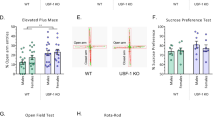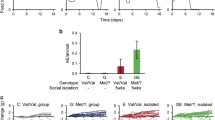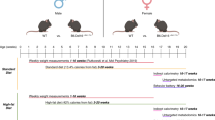Abstract
Individuals with Down syndrome (DS) have a higher prevalence of obesity compared to the general population. Conventionally, this has been attributed to endocrine issues and lack of exercise. However, deficits in neural reward responses and dopaminergic disturbances in DS may be contributing factors. To investigate this, we focused on a mouse model (Ts65Dn) bearing some triplicated genes homologous to trisomy 21. Through detailed meal pattern analysis in male Ts65Dn mice, we observed an increased preference for energy-dense food, pointing towards a potential “hedonic” overeating behavior. Moreover, trisomic mice exhibited higher scores in compulsivity and inflexibility tests when limited access to energy-dense food and quinine hydrochloride adulteration were introduced, compared to euploid controls. Interestingly, when we activated prelimbic-to-nucleus accumbens projections in Ts65Dn male mice using a chemogenetic approach, impulsive and compulsive behaviors significantly decreased, shedding light on a promising intervention avenue. Our findings uncover a novel mechanism behind the vulnerability to overeating and offer potential new pathways for tackling obesity through innovative interventions.







Similar content being viewed by others
Data availability
All the raw data and supplementary materials are available upon request.
References
Bell AJ, Bhate MS (1992) Prevalence of overweight and obesity in Down’s syndrome and other mentally handicapped adults living in the community. J Intellect Disabil Res. https://doi.org/10.1111/J.1365-2788.1992.TB00534.X
Yahia S, El-farahaty RM, El-Hawary AK, El-hussiny MA, Abdel-maseih H, El-Dahtory F, El-Gilany AH (2012) Leptin, insulin and thyroid hormones in a cohort of Egyptian obese Down syndrome children: a comparative study. BMC Endocr Disord. https://doi.org/10.1186/1472-6823-12-22
Campos C, Casado Á (2015) Oxidative stress, thyroid dysfunction & Down syndrome. Indian J Med Res 142(2):113–119. https://doi.org/10.4103/0971-5916.164218
Mahy J, Shields N, Taylor NF, Dodd KJ (2010) Identifying facilitators and barriers to physical activity for adults with Down syndrome. J Intellect Disabil Res 54(9):795–805. https://doi.org/10.1111/J.1365-2788.2010.01308.X
Grammatikopoulou MG, Manai A, Tsigga M, Tsiligiroglou-Fachantidou A, Galli-Tsinopoulou A, Zakas A (2008) Nutrient intake and anthropometry in children and adolescents with Down syndrome–a preliminary study. Dev Neurorehabil 11(4):260–267. https://doi.org/10.1080/17518420802525526
Nordstrøm M, Paus B, Andersen LF, Kolset SO (2015) Dietary aspects related to health and obesity in Williams syndrome, Down syndrome, and Prader-Willi syndrome. Food Nutr Res 3:59. https://doi.org/10.3402/FNR.V59.25487
Corwin RL, Hajnal A (2005) Too much of a good thing: neurobiology of non-homeostatic eating and drug abuse. Physiol Behav 86(1–2):5–8. https://doi.org/10.1016/J.PHYSBEH.2005.06.021
Kehagia AA, Murray GK, Robbins TW (2010) Learning and cognitive flexibility: frontostriatal function and monoaminergic modulation. Curr Opin Neurobiol 20(2):199–204. https://doi.org/10.1016/J.CONB.2010.01.007
Domingo-Rodriguez L, Ruiz de Azua I, Dominguez E, Senabre E, Serra I, Kummer S, Navandar M, Baddenhausen S, Hofmann C, Andero R, Gerber S, Navarrete M, Dierssen M, Lutz B, Martín-García E, Maldonado R (2020) A specific prelimbic-nucleus accumbens pathway controls resilience versus vulnerability to food addiction. Nat Commun. https://doi.org/10.1038/S41467-020-14458-Y
Willeumier KC, Taylor DV, Amen DG (2011) Elevated BMI is associated with decreased blood flow in the prefrontal cortex using SPECT imaging in healthy adults. Obesity (Silver Spring) 19(5):1095–1097. https://doi.org/10.1038/OBY.2011.16
Maayan L, Hoogendoorn C, Sweat V, Convit A (2011) Disinhibited eating in obese adolescents is associated with orbitofrontal volume reductions and executive dysfunction. Obesity (Silver Spring) 19(7):1382–1387. https://doi.org/10.1038/OBY.2011.15
Cohen JI, Yates KF, Duong M, Convit A (2011) Obesity, orbitofrontal structure and function are associated with food choice: a cross-sectional study. BMJ Open. https://doi.org/10.1136/BMJOPEN-2011-000175
Whittle N, Sartori SB, Dierssen M, Lubec G, Singewald N (2007) Fetal Down syndrome brains exhibit aberrant levels of neurotransmitters critical for normal brain development. Pediatrics. https://doi.org/10.1542/PEDS.2006-3448
Pujol J, del Hoyo L, Blanco-Hinojo L, de Sola S, Macià D, Martínez-Vilavella G, Amor M, Deus J, Rodríguez J, Farré M, Dierssen M, de la Torre R (2015) Anomalous brain functional connectivity contributing to poor adaptive behavior in Down syndrome. Cortex 1(64):148–156
Del Hoyo L, Xicota L, Langohr K, Sánchez-Benavides G, De Sola S, Cuenca-Royo A, Rodriguez J, Rodríguez-Morató J, Farré M, Dierssen M, De La Torre R (2016) VNTR-DAT1 and COMTVal158Met genotypes modulate mental flexibility and adaptive behavior skills in Down syndrome. Front Behav Neurosci. https://doi.org/10.3389/FNBEH.2016.00193
Palumbo ML, McDougle CJ (2018) Pharmacotherapy of Down syndrome. Expert Opin Pharmacother 19(17):1875–1889. https://doi.org/10.1080/14656566.2018.1529167
Dykens EM, Shah B, Davis B, Baker C, Fife T, Fitzpatrick J (2015) Psychiatric disorders in adolescents and young adults with Down syndrome and other intellectual disabilities. J Neurodev Disord. https://doi.org/10.1186/S11689-015-9101-1
Berthoud HR (2012) The neurobiology of food intake in an obesogenic environment. Proc Nutr Soc 71(4):478–487. https://doi.org/10.1017/S0029665112000602
Singh M (2014) Mood, food, and obesity. Front Psychol 5:1–35. https://doi.org/10.3389/FPSYG.2014.00925
Liu DP, Schmidt C, Billings T, Davisson MT (2003) Quantitative PCR genotyping assay for the Ts65Dn mouse model of Down syndrome. Biotechniques 35(6):1170–1180. https://doi.org/10.2144/03356ST02
Fructuoso M, Espinosa-Carrasco J, Erb I, Notredame C, Dierssen M (2019) Protocol for measuring compulsive-like feeding behavior in mice. Bio-Protoc. https://doi.org/10.21769/BIOPROTOC.3308
Bura SA, Burokas A, Martín-García E, Maldonado R (2010) Effects of chronic nicotine on food intake and anxiety-like behaviour in CB(1) knockout mice. Eur Neuropsychopharmacol 20(6):369–378. https://doi.org/10.1016/J.EURONEURO.2010.02.003
Paxinos and Franklin’s the Mouse Brain in Stereotaxic Coordinates - George Paxinos, Keith B.J. Franklin - Google Libros. [cited 2022 Dec 11]
Hothorn T, Bretz F, Westfall P (2008) Simultaneous inference in general parametric models. Biom J 50(3):346–363. https://doi.org/10.1002/BIMJ.200810425
Espinosa-Carrasco J, Burokas A, Fructuoso M, Erb I, Martín-García E, Gutiérrez-Martos M, Notredame C, Maldonado R, Dierssen M (2018) Time-course and dynamics of obesity-related behavioral changes induced by energy-dense foods in mice. Addict Biol 23(2):531–543. https://doi.org/10.1111/ADB.12595
Heyne A, Kiesselbach C, Sahún I, McDonald J, Gaiffi M, Dierssen M, Wolffgramm J (2009) An animal model of compulsive food-taking behaviour. Addict Biol 14(4):373–383. https://doi.org/10.1111/J.1369-1600.2009.00175.X
Kim HJ, Lee JH, Yun K, Kim JH (2017) Alterations in striatal circuits underlying addiction-like behaviors. Mol Cells 40(6):379–385. https://doi.org/10.14348/MOLCELLS.2017.0088
Carlin J, Hill-Smith TE, Lucki I, Reyes TM (2013) Reversal of dopamine system dysfunction in response to high-fat diet. Obesity (Silver Spring) 21(12):2513–2521. https://doi.org/10.1002/OBY.20374
Moreton E, Baron P, Tiplady S, McCall S, Clifford B, Langley-Evans SC, Fone KCF, Voigt JP (2019) Impact of early exposure to a cafeteria diet on prefrontal cortex monoamines and novel object recognition in adolescent rats. Behav Brain Res 2(363):191–198. https://doi.org/10.1016/J.BBR.2019.02.003
Wong C, Dwyer J, Holland M (2014) Overcoming weight problems in adults with down syndrome. Nutr Today 49(3):109–119. https://doi.org/10.1097/NT.0000000000000029
Fructuoso M, Rachdi L, Philippe E, Denis RG, Magnan C, Le Stunff H, Janel N, Dierssen M (2018) Increased levels of inflammatory plasma markers and obesity risk in a mouse model of Down syndrome. Free Radic Biol Med 1(114):122–130. https://doi.org/10.1016/J.FREERADBIOMED.2017.09.021
La Fleur SE, Luijendijk MCM, Van Der Zwaal EM, Brans MAD, Adan RAH (2014) The snacking rat as model of human obesity: effects of a free-choice high-fat high-sugar diet on meal patterns. Int J Obes (Lond) 38(5):643–649. https://doi.org/10.1038/IJO.2013.159
Smith CH, Teo Y, Simpson S (2014) An observational study of adults with Down syndrome eating independently. Dysphagia 29(1):52–60. https://doi.org/10.1007/S00455-013-9479-4
Richtsmeier JT, Zumwalt A, Carlson EJ, Epstein CJ, Reeves RH (2002) Craniofacial phenotypes in segmentally trisomic mouse models for Down syndrome. Am J Med Genet 107(4):317–324. https://doi.org/10.1002/AJMG.10175
Glass TJ, Twadell SL, Valmadrid LC, Connor NP (2019) Early impacts of modified food consistency on oromotor outcomes in mouse models of Down syndrome. Physiol Behav 1(199):273–281
Hennequin M, Allison PJ, Faulks D, Orliaguet T, Feine J (2005) Chewing indicators between adults with Down syndrome and controls. J Dent Res 84(11):1057–1061. https://doi.org/10.1177/154405910508401117
Si Hassen W, Castetbon K, Tichit C, Péneau S, Nechba A, Ducrot P, Lampuré A, Bellisle F, Hercberg S, Méjean C (2018) Energy, nutrient and food content of snacks in French adults. Nutr J. https://doi.org/10.1186/S12937-018-0336-Z
Corwin RL, Buda-Levin A (2004) Behavioral models of binge-type eating. Physiol Behav 82(1):123–130
Boggiano MM, Artiga AI, Pritchett CE, Chandler-Laney PC, Smith ML, Eldridge AJ (2007) High intake of palatable food predicts binge-eating independent of susceptibility to obesity: an animal model of lean vs obese binge-eating and obesity with and without binge-eating. Int J Obes (Lond) 31(9):1357–1367. https://doi.org/10.1038/SJ.IJO.0803614
McKeown DA, Doty RL, Perl DP, Frye RE, Simms I, Mester A (1996) Olfactory function in young adolescents with Down’s syndrome. J Neurol Neurosurg Psychiatry 61(4):412–414. https://doi.org/10.1136/JNNP.61.4.412
Bello NT, Yeh CY, Verpeut JL, Walters AL (2014) Binge-like eating attenuates nisoxetine feeding suppression, stress activation, and brain norepinephrine activity. PLoS ONE. https://doi.org/10.1371/JOURNAL.PONE.0093610
Granon S, Changeux JP (2012) Deciding between conflicting motivations: what mice make of their prefrontal cortex. Behav Brain Res 229(2):419–426. https://doi.org/10.1016/J.BBR.2011.11.011
Wright TM, Fone KCF, Langley-Evans SC, Voigt JPW (2011) Exposure to maternal consumption of cafeteria diet during the lactation period programmes feeding behaviour in the rat. Int J Dev Neurosci 29(8):785–793. https://doi.org/10.1016/J.IJDEVNEU.2011.09.007
Mobbs O, Crépin C, Thiéry C, Golay A, Van der Linden M (2010) Obesity and the four facets of impulsivity. Patient Educ Couns 79(3):372–377. https://doi.org/10.1016/J.PEC.2010.03.003
Evans DW, Gray FL (2000) Compulsive-like behavior in individuals with Down syndrome: its relation to mental age level, adaptive and maladaptive behavior. Child Dev 71(2):288–300. https://doi.org/10.1111/1467-8624.00144
Laskowski CS, Williams RJ, Martens KM, Gruber AJ, Fisher KG, Euston DR (2016) The role of the medial prefrontal cortex in updating reward value and avoiding perseveration. Behav Brain Res 1(306):52–63. https://doi.org/10.1016/J.BBR.2016.03.007
Brozoski TJ, Brown RM, Rosvold HE, Goldman PS (1979) Cognitive deficit caused by regional depletion of dopamine in prefrontal cortex of rhesus monkey. Science 205(4409):929–932. https://doi.org/10.1126/SCIENCE.112679
Dekker AD, Vermeiren Y, Albac C, Lana-Elola E, Watson-Scales S, Gibbins D, Aerts T, Van Dam D, Fisher EMC, Tybulewicz VLJ, Potier MC, De Deyn PP (2017) Aging rather than aneuploidy affects monoamine neurotransmitters in brain regions of Down syndrome mouse models. Neurobiol Dis 105:235–244. https://doi.org/10.1016/J.NBD.2017.06.007
Yates CM, Simpson J, Gordon A, Maloney AFJ, Allison Y, Ritchie IM, Urquhart A (1983) Catecholamines and cholinergic enzymes in pre-senile and senile Alzheimer-type dementia and Down’s syndrome. Brain Res 280(1):119–126. https://doi.org/10.1016/0006-8993(83)91179-4
Duval N, Vacano GN, Patterson D (2018) Rapamycin treatment ameliorates age-related accumulation of toxic metabolic intermediates in brains of the Ts65Dn mouse model of down syndrome and aging. Front Aging Neurosci. https://doi.org/10.3389/FNAGI.2018.00263
Décarie-Spain L, Hryhorczuk C, Fulton S (2016) Dopamine signalling adaptations by prolonged high-fat feeding. Curr Opin Behav Sci 1(9):136–143
Wang GJ, Geliebter A, Volkow ND, Telang FW, Logan J, Jayne MC, Galanti K, Selig PA, Han H, Zhu W, Wong CT, Fowler JS (2011) Enhanced striatal dopamine release during food stimulation in binge eating disorder. Obesity (Silver Spring) 19(8):1601–1608. https://doi.org/10.1038/OBY.2011.27
Kessler RM, Hutson PH, Herman BK, Potenza MN (2016) The neurobiological basis of binge-eating disorder. Neurosci Biobehav Rev 1(63):223–238. https://doi.org/10.1016/J.NEUBIOREV.2016.01.013
Vollbrecht PJ, Mabrouk OS, Nelson AD, Kennedy RT, Ferrario CR (2016) Pre-existing differences and diet-induced alterations in striatal dopamine systems of obesity-prone rats. Obesity (Silver Spring) 24(3):670–677. https://doi.org/10.1002/OBY.21411
Geiger BM, Haburcak M, Avena NM, Moyer MC, Hoebel BG, Pothos EN (2009) Deficits of mesolimbic dopamine neurotransmission in rat dietary obesity. Neuroscience 159(4):1193–1199. https://doi.org/10.1016/J.NEUROSCIENCE.2009.02.007
Johnson PM, Kenny PJ (2010) Dopamine D2 receptors in addiction-like reward dysfunction and compulsive eating in obese rats. Nat Neurosci 13(5):635–641. https://doi.org/10.1038/NN.2519
Rada P, Bocarsly ME, Barson JR, Hoebel BG, Leibowitz SF (2010) Reduced accumbens dopamine in Sprague-Dawley rats prone to overeating a fat-rich diet. Physiol Behav 101(3):394–400. https://doi.org/10.1016/J.PHYSBEH.2010.07.005
Volkow ND, Wang GJ, Tomasi D, Baler RD (2013) The addictive dimensionality of obesity. Biol Psychiatry 73(9):811–818. https://doi.org/10.1016/J.BIOPSYCH.2012.12.020
Chen BT, Yau HJ, Hatch C, Kusumoto-Yoshida I, Cho SL, Hopf FW, Bonci A (2013) Rescuing cocaine-induced prefrontal cortex hypoactivity prevents compulsive cocaine seeking. Nature 496(7445):359–362. https://doi.org/10.1038/NATURE12024
Moorman DE, James MH, McGlinchey EM, Aston-Jones G (2015) Differential roles of medial prefrontal subregions in the regulation of drug seeking. Brain Res 1628(Pt A):130–146. https://doi.org/10.1016/J.BRAINRES.2014.12.024
Hong J, Stubbins RE, Smith RR, Harvey AE, Núñez NP (2009) Differential susceptibility to obesity between male, female and ovariectomized female mice. Nutr J 17(8):1–5. https://doi.org/10.1186/1475-2891-8-11
Acknowledgements
Figure 6a–b were created with BioRender.com. We acknowledge the PRBB animal facility, and the CRG histology facility. We thank the Advanced Light Microscopy Unit (ALMU) at the CRG for their support in the confocal data acquisition process.
Funding
This work was supported by the Fondation Jérôme Lejeune #2002 (MD, MML, MF, AF), MINECO (PID2019-110755RB-I00/AEI/1013039/501100011033, RTC2019-007230-1 and RTC2019-007329-1 (MD, AF, MML, IT), Fundació La Marató De TV3 (201620-31) (EM.G, MD, MML, MF, IT) and 202212-30-31-32 (MD, MML, AFB), European Union’s Horizon 2020 research and innovation programme under grant agreement No 848077 (MD, MML, MF, AF), Brain Initiative (1R01EB 028159-01) (MD, MML) and grants from Université de Paris and CNRS (JD and NJ). ‘Plan Nacional Sobre Drogas of the Spanish Ministry of Health’ (#PNSD-2019I006) and Spanish Ministerio de Ciencia e Innovación (ERA-NET) PCI2021-122073-2A to E.M.-G. The laboratory of MD is supported by DIUE de la Generalitat de Catalunya (Grups Consolidats 2017 SGR 926). We acknowledge the support of the Spanish Ministry of Science and Innovation through the Centro de Excelencia Severo Ochoa (CEX2020-001049-S, MCIN/AEI/10.13039/501100011033), and the Generalitat de Catalunya through the CERCA programme. The CIBER of Rare Diseases is an initiative of the ISCIII. CS received the FI grant from Agència de Gestió d’Ajuts Universitaris i de Recerca (AGAUR) de la Generalitat de Catalunya, AFB received an FPI-SO fellowship (PRE2018-084504). J.D also acknowledges the Mass spectrometry platform of UMR 8601 laboratory.
Author information
Authors and Affiliations
Contributions
MD, MF, ÁF, EM and RM designed the experiments and discussed the results. MF, ÁF, AG and MMdL performed the experiments and MF, ÁF and AG analyzed the behavioral studies. MF, JD, and NJ performed and analyzed the bioamine determination by HPLC. CS quantified the expression of Ddr1 and Ddr2 by q-PCR. NL contributed to the acquisition of confocal images. IdT performed the correlations and statistical analysis between the behavioral and the brain bioamine’s data. MF, and ÁF did the statistical analysis of the results. MF, ÁF and MD wrote the manuscript. All authors commented on previous versions of the manuscript. All authors read and approved the final manuscript.
Corresponding author
Ethics declarations
Conflict of interest
The authors declare no competing financial interests.
Ethical approval and consent to participate
All experimental procedures were approved by the local ethical committee (Comité Ético de Experimentación Animal del PRBB (CEEA-PRBB); procedure number MDS-12-1464P3), and met the guidelines of the local (law 32/2007) and European regulations (EU directive n° 86/609, EU decree 2001-486) and the Standards for the use of Laboratory Animals n° A5388-01 (NIH).
Consent for publication
All authors consent for publication.
Additional information
Publisher's Note
Springer Nature remains neutral with regard to jurisdictional claims in published maps and institutional affiliations.
Supplementary Information
Below is the link to the electronic supplementary material.
Rights and permissions
Springer Nature or its licensor (e.g. a society or other partner) holds exclusive rights to this article under a publishing agreement with the author(s) or other rightsholder(s); author self-archiving of the accepted manuscript version of this article is solely governed by the terms of such publishing agreement and applicable law.
About this article
Cite this article
Fructuoso, M., Fernández-Blanco, Á., Gallego-Román, A. et al. Exploring the link between hedonic overeating and prefrontal cortex dysfunction in the Ts65Dn trisomic mouse model. Cell. Mol. Life Sci. 80, 370 (2023). https://doi.org/10.1007/s00018-023-05009-x
Received:
Revised:
Accepted:
Published:
DOI: https://doi.org/10.1007/s00018-023-05009-x




